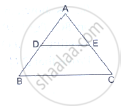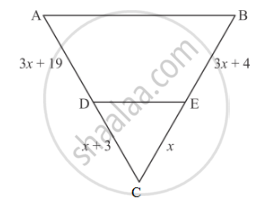Advertisements
Advertisements
Question
D and E are points on the sides AB and AC respectively of a ΔABC. In each of the following cases, determine whether DE║BC or not.
AB = 10.8cm, AD = 6.3cm, AC = 9.6cm and EC = 4cm.

Solution
We have:
AB = 10.8 cm, AD = 6.3 cm
Therefore,
DB = 10.8 – 6.3 = 4.5 cm
Similarly,
AC = 9.6 cm, EC = 4cm
Therefore,
AE = 9.6 – 4 = 5.6 cm
Now,
`(AD)/(DB)=6.3/4.5=7/5`
`(AE)/(EC)=5.6/4=7/5`
⟹`(AD)/(DB)=(AE)/(EC)`
Applying the converse of Thales’ theorem,
We conclude that DE ‖ BC.
APPEARS IN
RELATED QUESTIONS
What values of x will make DE || AB in the given figure?

In the given figure, DE || BD. Determine AC and AE.

In each of the following figures, you find who triangles. Indicate whether the triangles are similar. Give reasons in support of your answer.

Corresponding sides of two similar triangles are in the ratio 1 : 3. If the area of the smaller triangle in 40 cm2, find the area of the larger triangle.
State AAA similarity criterion.
In the figure given below DE || BC. If AD = 2.4 cm, DB = 3.6 cm, AC = 5 cm. Find AE.
If ∆ABC and ∆DEF are two triangles such that\[\frac{AB}{DE} = \frac{BC}{EF} = \frac{CA}{FD} = \frac{3}{4}\], then write Area (∆ABC) : Area (∆DEF)
In a ∆ABC, AD is the bisector of ∠BAC. If AB = 6 cm, AC = 5 cm and BD = 3 cm, then DC =
∆ABC ∼ ∆PQR such that ar(∆ABC) = 4 ar(∆PQR). If BC = 12 cm, then QR =
In an equilateral triangle ABC if AD ⊥ BC, then AD2 =
